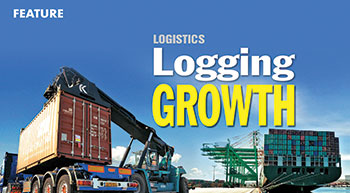The Indian logistics market is expected to grow at a CAGR of 12.17 per cent by 2020, driven by the growth in the manufacturing, retail, FMCG and e-commerce sectors.
India is expected to register a steady uptick in logistics growth, on the back of the improvement in the country´s infrastructural environment. However, the country spends around 14.4 per cent of its GDP on logistics and transportation, as compared to less than 8 per cent spent by other developing countries.
The growth in the logistics market is expected to give a leg-up to all associated sectors. The third-party logistics (3PL) market in India is expected to be worth $301.89 billion by 2020.
Market research firm NOVONOUS estimates that the warehouse market in India is expected to grow at a CAGR of 10 per cent. The freight forwarding market is expected to grow at a CAGR of 12 per cent till 2020.
This growth rate is based on the expectation that the government will soon implement the Goods & Service Tax (GST) regime, helping the logistics companies to optimise their operations to reduce costs and increase margins.
With the implementation of GST, the logistics companies, which are currently forced to set up many small warehouses across multiple cities, can set up just a few, big warehouses region-wise.
Under the new tax regime, they will be able to follow the hub-and-spoke model for freight movement from the warehouses to the different manufacturing plants, wholesale outlets, retail outlets and the various POS.
Logistics growth is also getting a leg up from the boom in e-commerce and the expansionary policies of various FMCG firms. This has increased the service geography of the logistics firms. However, they also have had to meet the demands of quick delivery and tight service-level agreements.
The Indian logistics industry spends around 14 per cent of the GDP on different types of cost incurred in logistics operations. The amount of cost incurred is very high in comparison to the logistics cost incurred by other nations. Logistics firms are moving from being traditional set-ups to the integration of IT and technology into their operations to reduce costs incurred, as well as to meet the service demands.
´We do have something like a Port Community System (PCS),´ says Vivek Kele, President, Association of Multimodal Transport Operators of India, ´but this is limited only to ports and operations. The private people operating out of the port are not linked to the PCS. This is the challenge that we have.´
However, with new investors and ideas entering the sector in India, new initiatives are afoot in technology. For instance, NEC Corporation and the DMIC Trust have established a joint venture company, DMICDC Logistics Data Services Limited, for providing logistics visualization services in India. This is the first commercial project to originate from the Smart Community initiatives of the Delhi Mumbai Industrial Corridor, which is being promoted jointly by the Indian and Japanese governments. The new company will provide shippers and transport operators with logistics visualization services, enabling them to perform real-time searches based on accurate positional information, showing the location of containers being transported by rail or road between Delhi and Mumbai.
´We will affix RFID tags to shipping containers being loaded and unloaded at ports in JNPT, Mumbai. We will also install RFID reader/writers at locations such as port entrances and exits, toll plazas on the expressway between Delhi and Mumbai, and inland container depots,´ says Piyush Sinha, CEO, DMIDC Logistics Data Services Ltd. The collected data will be analysed further to present operational metrics across the entire supply chain. This will make significant contributions to shortening shipping lead times, reducing inventory levels and improving the accuracy of production plans. To sum up, industry players have moved from being mere service providers to the position where they provide end-to-end supply chain solutions to their customers. However, there are still no large companies in this business. One can probably count on one´s fingers the numbers of logistics companies whose turnover exceeds a thousand crore. The need of the hour is to make the sector more investor friendly in order for the returns on investment to be worthwhile. Technology, warehousing, handling equipment all require varying degrees of investment. Setting up a container station, inland container depot or a port terminal, require, for instance, permissions from eight different ministries.
What is crucial is for logistics to be given industry status in order to make cheaper finance available. With escalating land costs, up to three years spent in procuring permissions and a host of other challenges, it is no wonder the industry has been marginalised with no businessmen willing to take risks in new ventures. Industry professionals say the government will do well to dwell on such issues and pave the way for smoother logistics operations in the days and years ahead.



Leave a Reply
You must be logged in to post a comment.